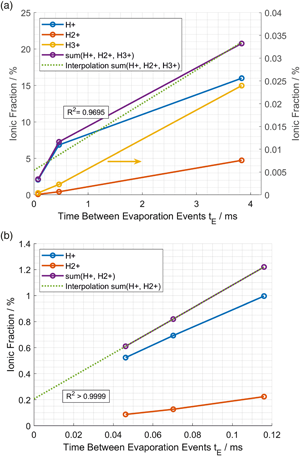Article contents
Extending Estimating Hydrogen Content in Atom Probe Tomography Experiments Where H2 Molecule Formation Occurs
Published online by Cambridge University Press: 28 July 2021
Abstract

We investigated a new method for estimating specimen hydrogen content in atom probe tomography (APT) in experiments where molecular hydrogen ions ( ${\rm H}_2^ +$) originating from the measurement environment can overlap with deuterium (D+) in the mass-to-charge-state spectrum, thus preventing the direct application of isotopic marking for unambiguous hydrogen analysis. First, we applied an existing method for hydrogen content estimation, using
${\rm H}_2^ +$) originating from the measurement environment can overlap with deuterium (D+) in the mass-to-charge-state spectrum, thus preventing the direct application of isotopic marking for unambiguous hydrogen analysis. First, we applied an existing method for hydrogen content estimation, using  ${\rm H}^ + {/}{\rm H}_2^ +$ ratios obtained from paired deuterated/nondeuterated experiments. These measurements demonstrated sufficient residual uncertainty to motivate exploring an alternative method to accurately estimate hydrogen content. By varying the time between evaporation events, it is then shown that a highly correlated relationship between field evaporation rate and hydrogen content exists and can also be used to predict hydrogen content. This leads to a new method for measuring hydrogen content within the specimen. We combine this extrapolation technique with continuous cycling of the evaporation rate or pulse frequency during an APT experiment. This could enable spatially resolved imaging of hydrogen concentrations despite the presence of a contaminant background hydrogen signal, without the need for deuteration.
${\rm H}^ + {/}{\rm H}_2^ +$ ratios obtained from paired deuterated/nondeuterated experiments. These measurements demonstrated sufficient residual uncertainty to motivate exploring an alternative method to accurately estimate hydrogen content. By varying the time between evaporation events, it is then shown that a highly correlated relationship between field evaporation rate and hydrogen content exists and can also be used to predict hydrogen content. This leads to a new method for measuring hydrogen content within the specimen. We combine this extrapolation technique with continuous cycling of the evaporation rate or pulse frequency during an APT experiment. This could enable spatially resolved imaging of hydrogen concentrations despite the presence of a contaminant background hydrogen signal, without the need for deuteration.
Keywords
- Type
- Detection of Hydrogen
- Information
- Copyright
- Copyright © The Author(s), 2021. Published by Cambridge University Press on behalf of the Microscopy Society of America
References
- 7
- Cited by





